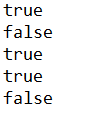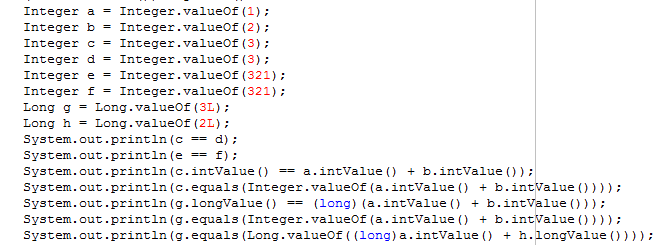通过实例了解Java Integer类和int的区别
代码实例如下
public static void main(String[] args) {
Integer i = 10;
Integer j = 10;
System.out.println(i == j);
Integer a = 128;
Integer b = 128;
System.out.println(a == b);
int k = 10;
System.out.println(k == i);
int kk = 128;
System.out.println(kk == a);
Integer m = new Integer(10);
Integer n = new Integer(10);
System.out.println(m == n);
}
我们使用反编译工具Jad,得到的代码如下:
public static void main(String args[])
{
Integer i = Integer.valueOf(10);
Integer j = Integer.valueOf(10);
System.out.println(i == j);
Integer a = Integer.valueOf(128);
Integer b = Integer.valueOf(128);
System.out.println(a == b);
int k = 10;
System.out.println(k == i.intValue());
int kk = 128;
System.out.println(kk == a.intValue());
Integer m = new Integer(10);
Integer n = new Integer(10);
System.out.println(m == n);
}
打印结果为:

首先,直接声明Integer i = 10,会自动装箱变为Integer i = Integer.valueOf(10);Integer i 会自动拆箱为 i.intValue()。
①、第一个打印结果为 true
对于 i == j ,我们知道这是两个Integer类,他们比较应该是用equals,这里用==比较的是地址,那么结果肯定为false,但是实际上结果为true,这是为什么?
我们进入到Integer 类的valueOf()方法:

分析源码我们可以知道在 i >= -128 并且 i <= 127 的时候,第一次声明会将 i 的值放入缓存中,第二次直接取缓存里面的数据,而不是重新创建一个Ingeter 对象。那么第一个打印结果因为 i = 10 在缓存表示范围内,所以为 true。
②、第二个打印结果为 false
从上面的分析我们知道,128是不在-128到127之间的,所以第一次创建对象的时候没有缓存,第二次创建了一个新的Integer对象。故打印结果为false
③、第三个打印结果为 true
Integer 的自动拆箱功能,也就是比较两个基本数据类型,结果当然为true
④、第四个打印结果为 true
解释和第三个一样。int和integer(无论new否)比,都为true,因为会把Integer自动拆箱为int再去比较。
⑤、第五个打印结果为 false
因为这个虽然值为10,但是我们都是通过 new 关键字来创建的两个对象,是不存在缓存的概念的。两个用new关键字创建的对象用 == 进行比较,结果当然为 false。
5、测试
Integer a = 1;
Integer b = 2;
Integer c = 3;
Integer d = 3;Integer e = 321;
Integer f = 321;Long g = 3L;
Long h = 2L;System.out.println(c == d);
System.out.println(e == f);
System.out.println(c == (a + b));
System.out.println(c.equals((a+b)));
System.out.println(g == (a+b));
System.out.println(g.equals(a+b));
System.out.println(g.equals(a+h));
反编译结果:

分析:第一个和第二个结果没什么疑问,Integer类在-128到127的缓存问题;
第三个由于 a+b包含了算术运算,因此会触发自动拆箱过程(会调用intValue方法),==比较符又将左边的自动拆箱,因此它们比较的是数值是否相等。
第四个对于c.equals(a+b)会先触发自动拆箱过程,再触发自动装箱过程,也就是说a+b,会先各自调用intValue方法,得到了加法运算后的数值之后,便调用Integer.valueOf方法,再进行equals比较。
第五个对于 g == (a+b),首先计算 a+b,也是先调用各自的intValue方法,得到数值之后,由于前面的g是Long类型的,也会自动拆箱为long,==运算符能将隐含的将小范围的数据类型转换为大范围的数据类型,也就是int会被转换成long类型,两个long类型的数值进行比较。
第六个对于 g.equals(a+b),同理a+b会先自动拆箱,然后将结果自动装箱,需要说明的是equals 运算符不会进行类型转换。所以是Long.equals(Integer),结果当然是false
第七个对于g.equals(a+h),运算符+会进行类型转换,a+h各自拆箱之后是int+long,结果是long,然后long进行自动装箱为Long,两个Long进行equals判断。
以上就是本文的全部内容,希望对大家的学习有所帮助,也希望大家多多支持我们。

